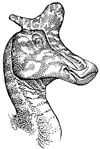The massive, hollow crests of duck-billed dinosaurs (also known as lambeosaurs, which lived up to 85 million years ago) might have been used to attract sexual partners or warn of predators, but one theory about the crests is now being sniffed at: that it was the main location of the dino’s sense of smell.
David Evans, a PhD student in zoology at the University of Toronto at Mississauga, reconstructed the brain and nasal cavity of the lambeosaur using fragments of fossil bone, and determined that the system responsible for the sense of smell did not change drastically in lambeosaur evolution. He also confirmed that it is unlikely that the crests evolved primarily to heighten sensitivity to smells. These findings add weight to two popular theories: that the complex nasal passages inside the crests were used to create honking noises to attract mates or warn of predators, and that the crests were used for visual display in mate selection or species recognition.
Recent Posts
U of T’s 197th Birthday Quiz
Test your knowledge of all things U of T in honour of the university’s 197th anniversary on March 15!
Are Cold Plunges Good for You?
Research suggests they are, in three ways
Work Has Changed. So Have the Qualities of Good Leadership
Rapid shifts in everything from technology to employee expectations are pressuring leaders to constantly adapt





